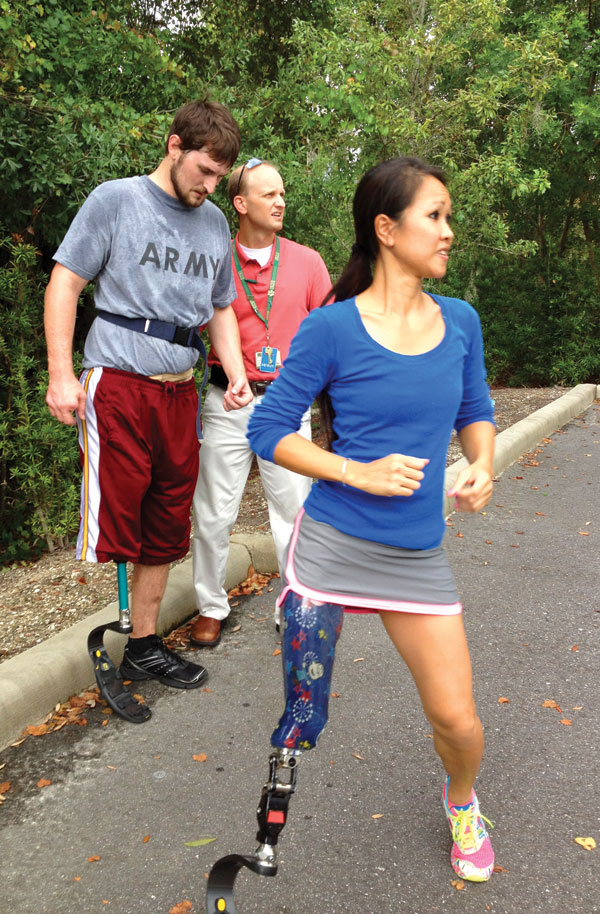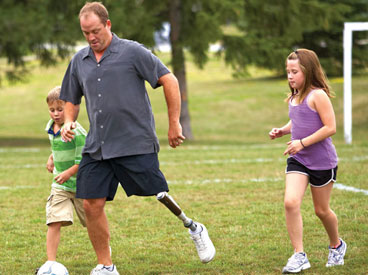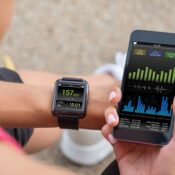
While returning veterans put new prostheses through their paces at BAMC, battlefield veterans and other amputees are trying similar technologies at the University of South Florida. USF’s Dr. Jason Highsmith recently carried out the study in which Voelpel participated, comparing the merits of the older C-Leg and the newer Genium. The Genium boasts six sensors that detect patient input, and the built-in microprocessor is designed to adapt continuously to this input. That means the knee recognizes, for instance, when to support wearers’ weight and when to bend slightly, making it easier for users to carry out precise movements that require good balance. “If the first generation of knees had one force sensor and one motion sensor, [now] you not only have basic touch but you have fine touch, you have pressure,” Highsmith says. “There’s more sensory input into the knee.”
The extra level of control allows Voelpel and other Genium wearers to execute routine tasks like walking and stair climbing with less difficulty. But these devices are still far short of the ideal. Just as uninjured people need merely think about making a specific arm or leg movement in order to do it, in the next generation of prosthetics, amputees’ thoughts will be linked to their artificial limbs to allow them intuitive neural control over their actions.
Levi Hargrove and Todd Kuiken, researchers at the Rehabilitation Institute of Chicago, have been working toward this goal for years. Kuiken’s magnum opus is an artificial arm with a connection to the nervous system. To prepare amputees to use the arm, he carries out a surgical procedure called targeted muscle reinnervation, transferring arm nerves that remain after amputation to muscles on the chest wall. These muscles biologically amplify signals coming from the arm nerves so that sensors can pick them up. The signals are then routed to a microcomputer, which uses special algorithms to interpret the signals and send them to the artificial arm. Once it receives the translated signals, the arm carries out the patient’s intended movement—“Stir coffee” for example. “We’ve improved the robustness of our system and have the devices good enough to deploy,” Kuiken says. “Now you can think ‘I want to open my hand,’ and you open your hand.” Kuiken made a splash in 2011 when he invited amputee Amanda Kitts onstage at a TED event to demonstrate how one of his experimental arms worked. Kitts bent and unbent her elbow, opened and closed her artificial hand, and even rotated her metal wrist 360 degrees, eliciting surprised laughter from the audience.
Hargrove is using a similar approach to develop artificial legs that are responsive to input from the wearer’s existing muscles. “When you walk, you activate muscles above and below your knee in a synergistic pattern,” he says. “So what we’re doing is starting to use signals from the residual leg muscles.” As a result, wearers can think of movements and the experimental prosthesis will carry them out. Unlike Kuiken’s robotic-arm test subjects, amputees who wear Hargrove’s leg will likely not have to undergo a surgical procedure, since existing nerves and muscles near the stump are sufficient to convey brain signals to the leg.
Zac Vawter, a software engineer who lost his leg in a motorcycle crash, recently climbed 103 flights of stairs to the top of Chicago’s Willis Tower while wearing Hargrove’s experimental leg. “Everything went great,” Vawter told the Associated Press after the event. “The prosthetic leg did its part, and I did my part.” Hargrove plans to test and retest the leg’s control system to ensure it is glitch-free before it’s rolled out to a wider group of users.
Meanwhile, at Stanford University and other institutions across the country, researchers are testing a device called BrainGate, designed to help paralyzed people and amputees achieve thought control over prostheses or computers. The device—an implant about the size of an aspirin tablet—picks up electrical signals from the brain. “There are 100 small protrusions on the bottom,” says Jaimie Henderson, co-director of Stanford’s Neural Prosthetics Translational Laboratory. “Those penetrate a small distance into the brain [and act] almost like tiny microphones so we can listen to the individual neurons.” When wearers think a command like “Pick up the ball,” the resulting brain signals are routed via attached wires and cables to an external computer. Specialized software interprets the commands encoded in the neuronal firing patterns and instructs a networked assistive device, such as an artificial arm, to carry them out.
BrainGate is currently in clinical trials to evaluate its usefulness in paralyzed patients, but Henderson foresees a long wait before the system becomes widely available. “One of the big challenges is that taking signals from the brain bypasses a lot of sophisticated circuitry that exists in the spinal cord,” he says. “It makes our computers do a lot more work to get to a naturalistic level of control.” And then there’s the challenge of miniaturization; right now, Henderson says, the system’s four computers and three monitors reside in a large cart. In order to be practically useful for patients with prostheses, the hardware would have to be much smaller—the size of a deck of cards, perhaps.
While trauma victims and combat veterans have long been the earliest beneficiaries of novel prosthetic technologies like these, smart artificial limbs have potential to transform the lives of chronic disease patients as well. About 65,000 people with diabetes lose a lower limb each year—with more than 60 percent of non-traumatic lower-limb amputations due to vascular disease, according to the CDC. These disease sufferers, Hargrove says, might actually be the patients who will end up benefiting most from the newest prostheses.
Still, the question must be asked: At what cost to America’s already burdened healthcare system? For a new prosthetic technology to be widely adopted, insurance companies and programs like Medicare have to be willing to cover it. That means researchers need to demonstrate that a new artificial limb helps wearers achieve significantly better function than they can manage with their existing prostheses. “If it’s twice the cost but a 5 percent improvement, does that justify the price?” Highsmith asks.
The answers to questions like that depend on whom you ask. John Voelpel, for one, hopes more amputees will be able to benefit from intuitive prostheses like the Genium. “It’s significantly better whether you’re standing, walking, or whatever. As an amputee, you tend to trust your own [good] leg a lot more than you trust the prosthetic leg,” he says. “With the Genium, you trust the prosthesis almost as much as you trust your own knee.”
Today’s fine-tuned replacement parts may not be panaceas, but they’re mileposts along the way to the ultimate goal: a prosthesis as natural, comfortable, and responsive as a real limb.
Watch Now: Todd Kuiken and Amanda Kitts demonstrate the capabilities of her prosthetic arm.
Become a Saturday Evening Post member and enjoy unlimited access. Subscribe now



